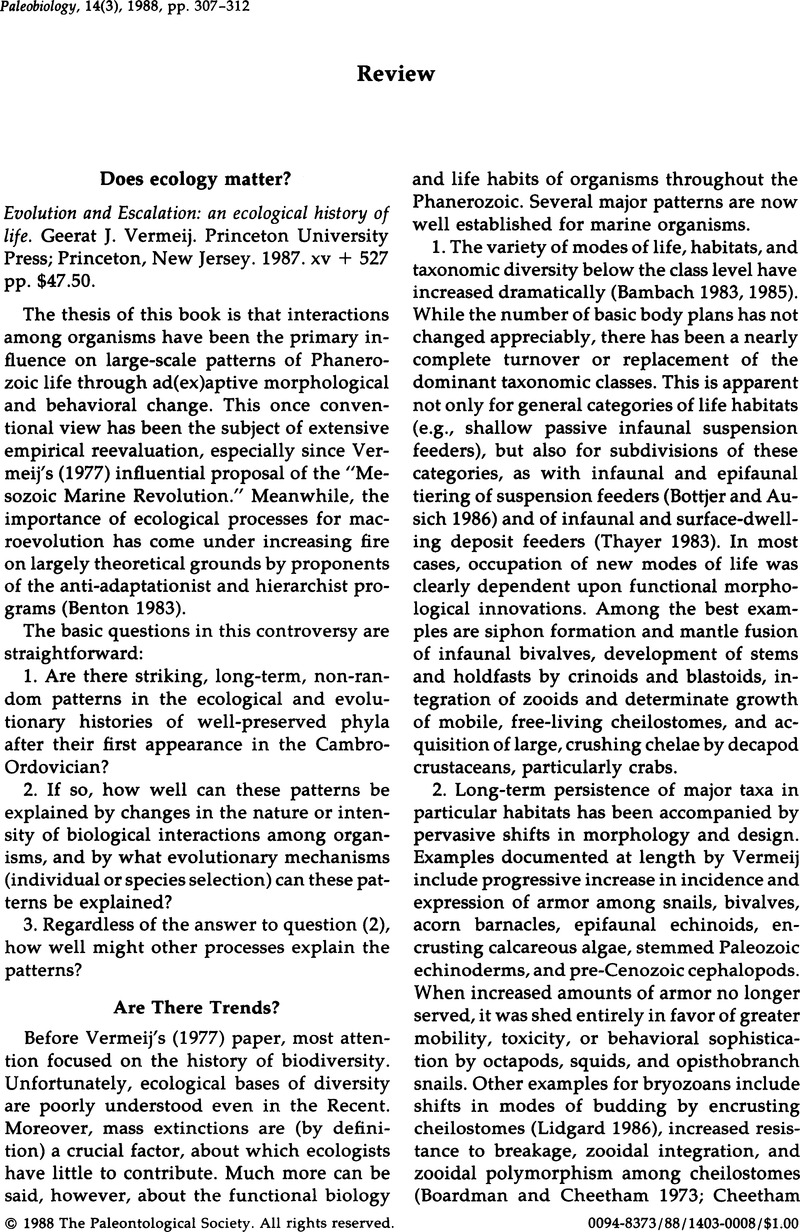Crossref Citations
This article has been cited by the following publications. This list is generated based on data provided by Crossref.
1989.
Evolution and extinction in the marine realm: some constraints imposed by phytoplankton.
Philosophical Transactions of the Royal Society of London. B, Biological Sciences,
Vol. 325,
Issue. 1228,
p.
279.
MASTERS, JUDITH C.
and
RAYNER, RICHARD J.
1993.
Competition and macroevolution: the ghost of competition yet to come?.
Biological Journal of the Linnean Society,
Vol. 49,
Issue. 1,
p.
87.
Lidgard, Scott
McKinney, Frank K.
and
Taylor, Paul D.
1993.
Competition, clade replacement, and a history of cyclostome and cheilostome bryozoan diversity.
Paleobiology,
Vol. 19,
Issue. 3,
p.
352.
Allmon, Warren D.
1994.
Taxic evolutionary paleoecology and the ecological context of macroevolutionary change.
Evolutionary Ecology,
Vol. 8,
Issue. 2,
p.
95.
Roy, Kaustuv
1996.
The roles of mass extinction and biotic interaction in large-scale replacements: a reexamination using the fossil record of stromboidean gastropods.
Paleobiology,
Vol. 22,
Issue. 3,
p.
436.
McKinney, Frank K.
Lidgard, Scott
Sepkoski, J. John
and
Taylor, Paul D.
1998.
Decoupled Temporal Patterns of Evolution and Ecology in Two Post-Paleozoic Clades.
Science,
Vol. 281,
Issue. 5378,
p.
807.
Funk, Daniel J.
1998.
ISOLATING A ROLE FOR NATURAL SELECTION IN SPECIATION: HOST ADAPTATION AND SEXUAL ISOLATION INNEOCHLAMISUS BEBBIANAELEAF BEETLES.
Evolution,
Vol. 52,
Issue. 6,
p.
1744.
Lupia, Richard
Lidgard, Scott
and
Crane, Peter R.
1999.
Comparing palynological abundance and diversity: implications for biotic replacement during the Cretaceous angiosperm radiation.
Paleobiology,
Vol. 25,
Issue. 3,
p.
305.
Wood, Rachel
2001.
Biodiversity and the history of reefs.
Geological Journal,
Vol. 36,
Issue. 3-4,
p.
251.
Dietl, Gregory P.
Kelley, Patricia H.
Barrick, Reese
and
Showers, William
2002.
ESCALATION AND EXTINCTION SELECTIVITY: MORPHOLOGY VERSUS ISOTOPIC RECONSTRUCTION OF BIVALVE METABOLISM.
Evolution,
Vol. 56,
Issue. 2,
p.
284.
Dietl, Gregory P.
Kelley, Patricia H.
Barrick, Reese
and
Showers, William
2002.
ESCALATION AND EXTINCTION SELECTIVITY: MORPHOLOGY VERSUS ISOTOPIC RECONSTRUCTION OF BIVALVE METABOLISM.
Evolution,
Vol. 56,
Issue. 2,
p.
284.
Yue, Li
and
Kershaw, Steve
2003.
Reef reconstruction after extinction events of the latest ordovician in the Yangtze platform, South China.
Facies,
Vol. 48,
Issue. 1,
p.
269.
Kelley, Patricia H.
Kowalewski, Michał
and
Hansen, Thor A.
2003.
Predator—Prey Interactions in the Fossil Record.
p.
1.
Kelley, Patricia H.
and
Hansen, Thor A.
2003.
Predator—Prey Interactions in the Fossil Record.
p.
113.
Harper, E.M.
2006.
Dissecting post-Palaeozoic arms races.
Palaeogeography, Palaeoclimatology, Palaeoecology,
Vol. 232,
Issue. 2-4,
p.
322.
Lidgard, Scott
Carter, Michelle C.
Dick, Matthew H.
Gordon, Dennis P.
and
Ostrovsky, Andrew N.
2012.
Division of labor and recurrent evolution of polymorphisms in a group of colonial animals.
Evolutionary Ecology,
Vol. 26,
Issue. 2,
p.
233.



